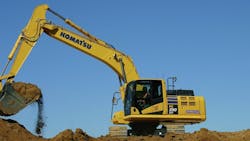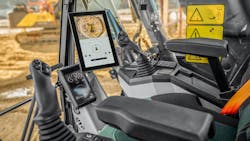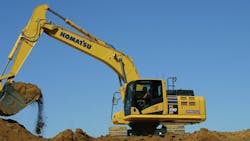Although the more frequent introductions of compact and so-called “midi” excavators grab the headlines, there have been some have been some significant new medium-to-large workhorses recently introduced in the 60,000- to 80,000-pound range.
These models are usually loaded with technology aimed at making operation easier and more efficient.
Link-Belt 370 X4S
Link-Belt has released the 370 X4S excavator, a 268-horsepower unit that digs to 24 feet 2 inches. Bucket digging force on the Link-Belt 370 X4S is 56,160 lb.-ft.
The excavator has an electronically controlled in-line hydraulic pump system and uses the Spool Stroke Control system. Custom Flow Balance allows operators to adjust flow priorities to match operating styles and maximize productivity.
Technology on the 370 X4S includes WAVES that provides a tri-camera 270-degree view. Other standard technologies include Dynamic Stability Assist, Height and Depth Alarm, Digital Level, and Payload to measure bucket volume. A high-definition, 10-inch, LCD monitor features an anti-glare coating for visibility in all lighting conditions, the company says.
Volvo Next Gen Excavators
In a recent double introduction, Volvo Construction Equipment has upgraded two large excavators to its next generation.
The company’s next generation is characterized by greater fuel efficiency, increased productivity, and cab upgrades. The all-new EC260 replaces the EC250 in Volvo’s lineup, and the new EC300 is an update of the previous series’ model.
“These 26- and 30-ton models are popular sizes for site preparation, road building, and utility applications,” said S.S. Kim, product manager—mid-size excavators at Volvo. “And now customers can do these jobs while stretching their fuel supply farther and making operators happier and more productive.”
The new models feature up to 15% greater fuel efficiency compared to their predecessors, according to the company.
"Our customers are looking for ways to increase productivity and reduce expenses, and we deliver on that with these new excavators,” said Sejong Ko, product manager--large excavators, at Volvo CE. “Fuel in particular is a major expense, and the improved fuel efficiency will reduce costs with the added benefit of lowering the environmental impact.
When next generation introductions started last May, the new series represented the most significant update to the Volvo excavator lineup in two decades. “This new excavator series is the realization of our commitment to our customers," said Scott Young, head of Region North America for Volvo. "Every design change, innovation, and weld were made with our customers' needs top of mind. All together, these updates will substantially impact their productivity, uptime, employee satisfaction, and ultimately, their success.”
The 260-horsepower Volvo EC300 is a 68,000-pound machine that digs to 24 feet 1 inch. Bucket capacity is 1.98 cubic yards, and the excavator has a max digging reach of 35 feet 2 inches. Breakout force is 44,300 lb.-ft., and lifting capacity is 19,158 pounds.
The Volvo EC260 digs to 23 feet 2 inches with a maximum digging reach of 33 feet 11 inches. The 59,000-pound excavator is powered by a 231-horsepower diesel engine. Bucket capacity is 1.73 cubic yards, and breakout force is 37,320 lb.-ft.
Mentioned in this article
- Link-Belt 370 X4S Excavator
- Volvo EC260, EC300 Excavators
-
Volvo Active Control for Excavators Integrates Topcon 3D-MC Software
- Caterpillar 335 Excavator
- Cat Grade Available for Mini Excavators
- Komatsu PC290LCi-11 Excavator
- Hitachi Upgrades Zaxis-7 Medium, Large Excavators
- Caterpillar 325 Excavator
- Caterpillar 330 Excavators
The EC260 and EC300, along with other excavators in the series, feature:
- An optimized electro-hydraulic system, smart cooling system, and engine speed regulation that contribute to the 15% better fuel efficiency.
- Better machine control for smooth and precise movement of the boom, bucket, and other hydraulic components.
- Ten work modes, including two specific to power and four specific to automatic ECO modes.
- A new creep travel mode coupled with boom and arm shock reduction for reduced spillage and added safety.
- Volvo Smart View with Obstacle Detection, which gives operators 360-degree visibility of the machine’s surroundings and the ability to distinguish between objects and humans.
- The Volvo Active Control machine-control system and an advanced electric joystick that together automate boom and bucket movement.
- A 50% increase in hydraulic oil life with service intervals extended to 3,000 hours for regular hydraulic oil and 6,000 hours for long-life hydraulic oil.
The cab also received a major makeover, with several updates designed to improve operator comfort, productivity, and safety, including:
- An updated seat, a larger heated side mirror, and additional lights, sun screens, and storage areas.
- Keyless start with the ability to store multiple operator preference settings.
- An improved human-machine interface (HMI) and a larger, higher-resolution Co-Pilot tablet for helpful applications like on-board weighing and in-field design.
JCB 370X Excavator
Though a little heavy for this category, it's notable that JCB has introduced its largest excavator, the 322-horsepower. The 370X has a maximum dig depth of 27 feet 4 inches. Its Cummins diesel delivers 322 horsepower at 1,700 rpm for fuel economy and low noise levels.
A Kawasaki tandem hydraulic pump delivers 5,076 psi pressure, rising to 5,511 psi during power boost cycles.
A 21-foot monoboom is standard, with arm choices of 8.6 feet, 10.6 feet, and 13.2 feet. Optional heavy-duty arms have additional crush bars and reinforcement. The machine can be fitted with a JCB dual-pin coupler to pick up 3.53-inch or 3.93-inch attachments.
“With the introduction of the 370X, JCB takes yet another step forward this year in our goal of providing a comprehensive range of heavy equipment solutions for the construction industry,” said Sam Wagstaff, products manager, JCB North America.“At this end of the excavator market, contractors know they need strong, powerful machines with the latest technology to get the big jobs done on time and on budget,” Wagstaff said. “The JCB 370X excels in these attributes while lowering total cost of ownership and providing operators with a cab that keeps them comfortable and productive over the course of long days and challenging applications.”
The traditional excavator stalwarts like Hitachi, Caterpillar, and John Deere continue to offer the most choices in the category.
Hitachi models include the ZX300LC-6, ZX300LC-7H, ZX345USLC-6, ZX345USLC-7H, and ZX350LC-7H, ranging from 249 to 271 horsepower.
Caterpillar has promoted its next generation of excavators, which for the 60,000- to 80,000-pound category means the 325, 330, 330GC, and 335. Its next generation hallmarks include a number of standard technologies to help the contractor achieve greater levels of productivity, enhanced safety, improved accuracy, and overall greater efficiency on the job.
The new advanced electro-hydraulic systems combine the electronic intelligence and flexibility with highly efficient hydraulic components. These enable key benefits such as lower fuel consumption, adjustable user control settings, feature upgrades, and automation, Cat says.
Smart hydraulics combined with advanced sensors and logic enable significant efficiency gains through the use of standard technologies such as Cat Grade, Cat Grade with Assist, Payload, and Lift Assist. The standard Grade technology is meant to help operators achieve grade faster and with greater accuracy, and without the risk of costly overdigging. The standard Payload technology prevents operators from overloading or underloading trucks, as well as tracking productivity whether truckloading, trenching, or stockpiling.
John Deere has the 250 P Tier, 300 P Tier, 345 P Tier, which Deere considers as mid-sized models in its portfolio. P Tier denotes "Performance Tier," sort of a middle ground in productivity and technology including features like E-H controls and enhanced linkage designs, with X-Tier being "fully loaded" machines with the most technology.
Komatsu offers one of its intelligent excavators in the category, the PC290LCi-11. Intelligent excavators have the company's Intelligent Machine Control that helps operators make grade and minimize overdigging.
It is interesting to note that hybrid excavators have fallen somewhat silent from a promotion and introduction standpoint as OEMs work on larger battery-electric or hydrogen-powered prototypes. So far, the largest electric excavator available to North America from a major manufacturer is the 57,000-pound Volvo EC230, not quite in this category.
About the Author
Frank Raczon
Raczon’s writing career spans nearly 25 years, including magazine publishing and public relations work with some of the industry’s major equipment manufacturers. He has won numerous awards in his career, including nods from the Construction Writers Association, the Association of Equipment Manufacturers, and BtoB magazine. He is responsible for the magazine's Buying Files.



